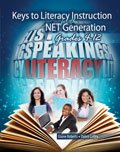What is digital literacy? Looking for ways to build digital literacy in your students by integrating literacy skills and technology into the content areas? A common working definition for digital literacy is:
“Digital literacy is the skills, knowledge, creativity and attitudes that are necessary to be able to use digital media for learning and mastering in the Knowledge Society. It is this literacy that builds a bridge between skills such as reading, writing and arithmetic, and the literacy that is needed to be able to use new digital tools and media in a creative and critical way.”
 Digital literacy, when applied to media in print and electronic form, can help students build reading, writing, listening, speaking, and viewing skills. In Elaine Roberts and Debra Coffey’s Keys to Literacy Instruction for the NET Generation, Grades 4-12, the authors compiled a list of web tools to aid students in making sense of the content and move toward a student-centered, project-based learning environment, I’ve included a few here.
Digital literacy, when applied to media in print and electronic form, can help students build reading, writing, listening, speaking, and viewing skills. In Elaine Roberts and Debra Coffey’s Keys to Literacy Instruction for the NET Generation, Grades 4-12, the authors compiled a list of web tools to aid students in making sense of the content and move toward a student-centered, project-based learning environment, I’ve included a few here.
Glogster.edu is a presentation tool for students to publish information through images, links, videos, audio, and texts. Most often Glogters surface in classrooms as digital posters, usually to inform on a topic. What would an interactive Glogster look like? Could students collaborate with students inside and outside of their classroom? What sort of viewing tools would make sense for students to use as they read and respond to a glog?
Creaza is a presentation tool for students to create and communicate with their audiences in the form of film, complex text, radio commercials, radio plays, mind minds, presentations, cartoon, digital stories, etc. In this example, the author imported original cartoon drawings into the movie maker to make this short film. How might collaboration inside of a Creaza presentation look inside an elementary, middle, or high classroom? Who might be the audience for these publishable pieces?
Class Dojo is a behavior management system that allows a teacher to enter his/her students and track their behavior or actions with a point system. For instance, a teacher can give a student a point for helping others, being on task, participating, persistence, team work, and/or working hard. If the teacher decides to project the class roster, students have access to immediate feedback to know when they receive points for these behaviors and actions. All collected data can be shared with students, parents, and administrators. What is the added value of a management system such as this?
Game Star Mechanic is a program that allows student to design their own video games and teachers to share lesson designs. The literacy skills the program taps into include 21st century skills, systems thinking, creative problem solving, art and aesthetics, writing and storytelling, and STEM learning. Multiple content specific lesson plans are available online as models. Game Based Learning (GBL), as we’re learning, does have classroom benefits including reinforcing content through technology-enhanced learning experiences. Can game designs accurately target content standards while being relevant to students?
What tools are you using to build digital literacy in your students? What impact are those tools having on the learning experience? Share your practices inside this global community.
